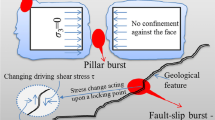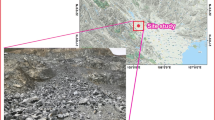Abstract
Penetrability is a dominant factor in selecting the suitable drilling method, adjustment of machine parameters and tool wear analysis. In this paper, it is aimed to classify the rock penetrability using Artificial Bee Colony (ABC) algorithm as one of the powerful meta-heuristic algorithms and Self-Organizing Map (SOM) as one of the precise scientific tools. For this purpose, eight different rocks from open pit mines and highway slopes were classified into four separate clusters according to physical and mechanical properties of rock including uniaxial compressive strength, mean Mohs hardness, Young modulus and Schimazek’s F-abrasivity. To evaluate and validate the obtained clusters, field studies were performed and the drilling rate of studied rocks was measured. The results of field study were compared with the results of ABC algorithm and SOM. The results showed that, the studied rocks were reliably classified with respect to their drilling rate. It is concluded that applied techniques can be used for solving the complex rock engineering problems specially in engineering classification of rocks.




Similar content being viewed by others
References
Arabjamaloei R, Karimi Dehkordi B (2012) Investigation of the most efficient approach of the prediction of the rate of penetration. Energy Sources Part A: Recovery Utilization Environ Eff 34(7):581–590. https://doi.org/10.1080/15567036.2010.493925
Armaghani DJ, Hasanipanah M, Mahdiyar A, Majid MZA, Amnieh HB, Tahir MM (2016) Airblast prediction through a hybrid genetic algorithm-ANN model. Neural Comput Appl. https://doi.org/10.1007/s00521-016-2598-8
Ataei M, KaKaie R, Ghavidel M, Saeidi O (2015) Drilling rate prediction of an open pit mine using the rock mass drillability index. Int J Rock Mech Min Sci 73:130–138. https://doi.org/10.1016/j.ijrmms.2014.08.006
Basarir H, Tutluoglu L, Karpuz C (2014) Penetration rate prediction for diamond bit drilling by adaptive neuro-fuzzy inference system and multiple regressions. Eng Geol 173:1–9. https://doi.org/10.1016/j.enggeo.2014.02.006
Bouzon M, Govindan K, Rodriguez CMT, Campos LM (2016) Identification and analysis of reverse logistics barriers using fuzzy Delphi method and AHP. Resour Conserv Recycl 108:182–197. https://doi.org/10.1016/j.resconrec.2015.05.021
Cheniany A, Khoshrou SH, Shahriar K, Hamidi JK (2012) An estimation of the penetration rate of rotary drills using the specific rock mass drillability index. Int J Rock Mech Min Sci 22:187–193. https://doi.org/10.1016/j.ijmst.2011.09.001
Chipperfield A, Fleming P, Pohlheim H (2006) Genetic algorithm toolbox for use with MATLAB user’s guide, version 1.2 edn. University of Sheffield, Sheffield
Das SK, Basudhar PK (2009) Utilization of self-organizing map and fuzzy clustering for site characterization using piezocone data. Comput Geotech 36(1):241–248. https://doi.org/10.1016/j.compgeo.2008.02.005
Dell’Orco M, Başkan Ö, Marinelli M (2014) Artificial Bee Colony-based algorithm for optimising traffic signal timings. In: Snášel V, Krömer P, Köppen M, Schaefer G (eds) Soft computing in industrial applications. Advances in intelligent systems and computing, vol 223. Springer, Cham
Dorigo M (1992) Optimization, learning and natural algorithms. Ph.D. thesis, Politecnico di Milano, Italy
Dorigo M, Maniezzo V, Colorni A (1996) Ant system: optimization by a colony of cooperating agents. IEEE Trans Syst Man Cybern Part B Cybern 26(1):29–41. https://doi.org/10.1109/3477.484436
Eberhart RC, Kennedy J (1995) A new optimizer using particle swarm theory. In: Proceedings of the sixth international symposium on micro machine and human science (vol 1, pp 39–43). https://doi.org/10.1109/ICNN.1995.488968
Ekincioglu G, Altindag R, Sengun N, Demirdag S, Guney A (2013) The relationships between drilling rate index (DRI), physico-mechanical properties and specific cutting energy for some carbonate rocks. In: Rock mechanics for resources, energy and environment, pp 867–873. doi:https://doi.org/10.1201/b15683-149
Fekrmandi H, Unal M, Neva SR, Tansel IN, McDaniel D (2016) A novel approach for classification of loads on plate structures using artificial neural networks. Measurement 82:37–45. https://doi.org/10.1016/j.measurement.2015.12.027
Haghshenas SS, Neshaei MAL, Pourkazem P, Haghshenas SS (2016a) The risk assessment of dam construction projects using fuzzy TOPSIS (case study: Alavian Earth Dam). Civ Eng J 2(4):158–167
Haghshenas SS, Haghshenas SS, Barmal M, Farzan N (2016b) Utilization of soft computing for risk assessment of a tunneling project using geological units. Civ Eng J 2(7):358–364
Haghshenas SS, Mikaeil R, Haghshenas SS, Naghadehi MZ, Moghadam PS (2017a) Fuzzy and classical MCDM techniques to rank the slope stabilization methods in a rock-fill reservoir dam. Civ Eng J 3(6):382–394
Haghshenas SS, Haghshenas SS, Mikaeil R, Sirati Moghadam P, Haghshenas AS (2017b) A new model for evaluating the geological risk based on geomechanical properties—case study: the second part of emamzade hashem tunnel. Electron J Geotech Eng 22(01):309–320 (Available at ejge.com)
Hoseinie SH, Aghababaei H, Pourrahimian Y (2008) Development of a new classification system for assessing of rock mass drillability index (RDi). Int J Rock Mech Min Sci 45:1–10. https://doi.org/10.1016/j.ijrmms.2007.04.001
Hoseinie SH, Ataei M, Osanloo M (2009) A new classification system for evaluating rock penetrability. Int J Rock Mech Min Sci 46:1329–1340. https://doi.org/10.1016/j.ijrmms.2009.07.002
Hoseinie SH, Ataei M, Mikaeil R (2012) Comparison of some rock hardness scales applied in drillability studies. Arab J Sci Eng 37:1451–1458. https://doi.org/10.1007/s13369-012-0247-9
Kahraman S (1999) Rotary and percussive drilling prediction using regression analysis. Int J Rock Mech Min Sci 36:981–989. https://doi.org/10.1016/S0148-9062(99)00050-9
Kahraman S, Balcı C, Yazıcı S, Bilgin N (2000) Prediction of the penetration rate of rotary blast hole drills using a new drillability index. Int J Rock Mech Min Sci 37:729–743. https://doi.org/10.1016/S1365-1609(00)00007-1
Kahraman S, Bilgin N, Feridunoglu C (2003) Dominant rock properties affecting the penetration rate of percussive drills. Int J Rock Mech Min Sci 40:711–723. https://doi.org/10.1016/S1365-1609(03)00063-7
Kang F, Li J, Xu Q (2009) Structural inverse analysis by hybrid simplex artificial bee colony algorithms. Comput Struct 87(13–14):861–870. https://doi.org/10.1016/j.compstruc.2009.03.001
Karaboga D (2005) An idea based on honey bee swarm for numerical optimization, Technical Report-TR06, Erciyes University, Engineering Faculty, Computer Engineering Department
Karaboga D, Akay B (2011) A modified artificial bee colony (ABC) algorithm for constrained optimization problems. Appl Soft Comput 11(3):3021–3031. https://doi.org/10.1016/j.asoc.2010.12.001
Karaboga D, Gorkemli B, Ozturk C, Karaboga N (2014) A comprehensive survey: artificial bee colony (ABC) algorithm and applications. Artif Intell Rev 42(1):21–57. https://doi.org/10.1007/s10462-012-9328-0
Karpuz C, Pasamehmetoglu AG, Dincer T, Muftuoglu Y (1990) Drillability studies on the rotary blast hole drilling of lignite overburden series. Int J Surf Min Reclam Environ 4:89–93. https://doi.org/10.1080/09208119008944172
Khalokakaie R, Ataei M, Mikaiel R, Hoseinie SH (2011) A fuzzy logic based classification for assessing of rock mass drillability. Int J Min Miner Eng 3(4):278–289. https://doi.org/10.1504/IJMME.2011.045470
Khandelwal M, Armaghani DJ (2016) Prediction of drillability of rocks with strength properties using a hybrid GA-ANN technique. Geotech Geol Eng 34(2):605–620. https://doi.org/10.1007/s10706-015-9970-9
Kuo RJ, Mei CH, Zulvia FE, Tsai CY (2016) An application of a metaheuristic algorithm-based clustering ensemble method to APP customer segmentation. Neurocomputing 205:116–129. https://doi.org/10.1016/j.neucom.2016.04.017
Lloyd SP (1982) Least squares quantization in pcm. IEEE Trans Inf Theory 28:129–137
Menhaj MB (2008) Computational intelligence (vol 1), Fundamentals of neural networks. Amir Kabir University Press. ISBN; 978-964-463-087-3
Mikaeil R, Haghshenas SS, Haghshenas SS, Ataei M (2016a) Performance prediction of circular saw machine using imperialist competitive algorithm and fuzzy clustering technique. Neural Comput Appl. https://doi.org/10.1007/s00521-016-2557-4
Mikaeil R, Ozcelick Y, Ataei M, ShaffieeHaghshenas S (2016b) Application of harmony search algorithm to evaluate the performance of diamond wire saw. J Min Environ. https://doi.org/10.22044/jme.2016.723
Mikaeil R, Haghshenas SS, Shirvand Y, Hasanluy MV, Roshanaei V (2016c) Risk assessment of geological hazards in a tunneling project using harmony search algorithm (case study: Ardabil-Mianeh railway tunnel). Civ Eng J 2(10):546–554
Mikaeil R, Ataei M, Javanshir GM, Haghshenas SS (2016d). Clustering of collapsibility of roof rock in coal mines using SOM. In: 3rd National Iranian coal congress
Mirjalili SZ, Saremi S, Mirjalili SM (2015) Designing evolutionary feedforward neural networks using social spider optimization algorithm. Neural Comput Appl 26(8):1919–1928. https://doi.org/10.1007/s00521-015-1847-6
Ozturk C, Hancer E, Karaboga D (2015) Improved clustering criterion for image clustering with artificial bee colony algorithm. Pattern Anal Appl 18(3):587–599. https://doi.org/10.1007/s10044-014-0365-y
Rad MY, Haghshenas SS, Kanafi PR, Haghshenas SS (2012) Analysis of protection of body slope in the rockfill reservoir dams on the basis of fuzzy logic. In: IJCCI (pp 367–373). doi:https://doi.org/10.5220/0004153803670373
Rad MY, Haghshenas SS, Haghshenas SS (2014) Mechanostratigraphy of cretaceous rocks by fuzzy logic in East Arak, Iran. In: The 4th international workshop on computer science and engineering (WCSE 2014), Dubai
Rafiee R, Ataei M, KhalooKakaie R (2015) A new cavability index in block caving mines using fuzzy rock engineering system. Int J Rock Mech Min Sci 77:68–76. https://doi.org/10.1016/j.ijrmms.2015.03.028
Rao RV, Pawar PJ (2009) Modelling and optimization of process parameters of wire electrical discharge machining. Proc Inst Mech Eng B J Eng Manuf 223(11):1431–1440. https://doi.org/10.1243/09544054JEM1559
Rezaei F, Ahmadzadeh MR, Safavi HR (2016) SOM-DRASTIC: using self-organizing map for evaluating groundwater potential to pollution. Stoch Environ Res Risk Assess. https://doi.org/10.1007/s00477-016-1334-3
Sabzi HZ, Humberson D, Abudu S, King JP (2016) Optimization of adaptive fuzzy logic controller using novel combined evolutionary algorithms, and its application in Diez Lagos flood controlling system, Southern New Mexico. Expert Syst Appl 43:154–164. https://doi.org/10.1016/j.eswa.2015.08.043
Sonmez M (2011) Articial Bee Colony algorithm for optimization of truss structures. Appl Soft Comput 11(2):2406–2418. https://doi.org/10.1016/j.asoc.2010.09.003
Teodorović D, Dell’Orco M (2005) Bee colony optimization—a cooperative learning approach to complex transportation problems. In: Advanced OR and AI methods in transportation: proceedings of 16th mini–EURO conference and 10th meeting of EWGT (13–16 September 2005)—Poznan: Publishing House of the Polish Operational and System Research (pp 51–60)
Thuro K, Spaun G, (1996) Introducing ‘the destruction work’ as a new rock property of toughness referring to drillability in conventional drill-and blast tunnelling. In: ISRM international symposium-EUROCK 96. International Society for Rock Mechanics, 1996
Yagiz S, Karahan H (2015) Application of various optimization techniques and comparison of their performances for predicting TBM penetration rate in rock mass. Int J Rock Mech Min Sci 80:308–315. https://doi.org/10.1016/j.ijrmms.2015.09.019
Yang XS (2011) Nature-inspired metaheuristic algorithms. 2010. Firefly algorithm, pp 79–90
Zhang S, Lee CKM, Choy KL, Ho W, Ip WH (2014) Design and development of a hybrid artificial bee colony algorithm for the environmental vehicle routing problem. Trans Res Part D Transp Environ 31:85–99. https://doi.org/10.1016/j.trd.2014.05.015
Zhou Y, Luo Q, Xie J, Zheng H (2016) A hybrid bat algorithm with path relinking for the capacitated vehicle routing problem. In: Yang X-S, Bekdaş G, Nigdeli SM (eds) Metaheuristics and optimization in civil engineering. Springer, Cham, pp 255–276. https://doi.org/10.1007/978-3-319-26245-1_12
Acknowledgements
The authors would like to express their appreciation to Professor Mahdi Ghaem for his helpful advices and technical support.
Author information
Authors and Affiliations
Corresponding author
Rights and permissions
About this article
Cite this article
Mikaeil, R., Haghshenas, S.S. & Hoseinie, S.H. Rock Penetrability Classification Using Artificial Bee Colony (ABC) Algorithm and Self-Organizing Map. Geotech Geol Eng 36, 1309–1318 (2018). https://doi.org/10.1007/s10706-017-0394-6
Received:
Accepted:
Published:
Issue Date:
DOI: https://doi.org/10.1007/s10706-017-0394-6




